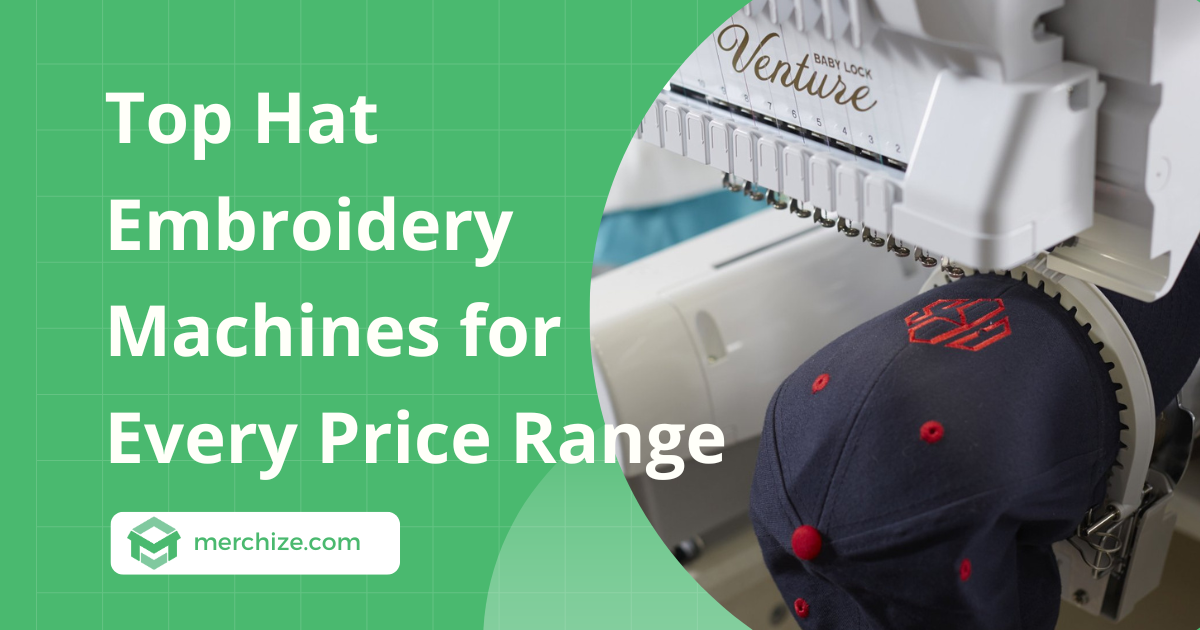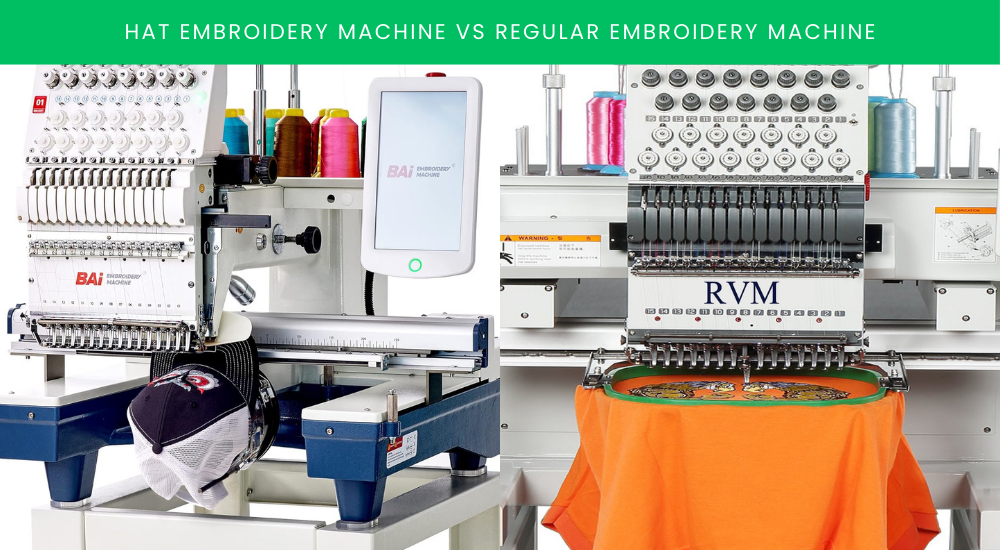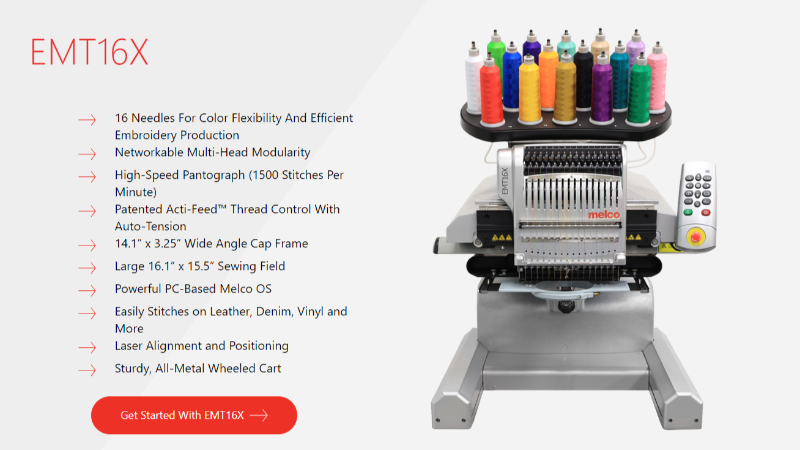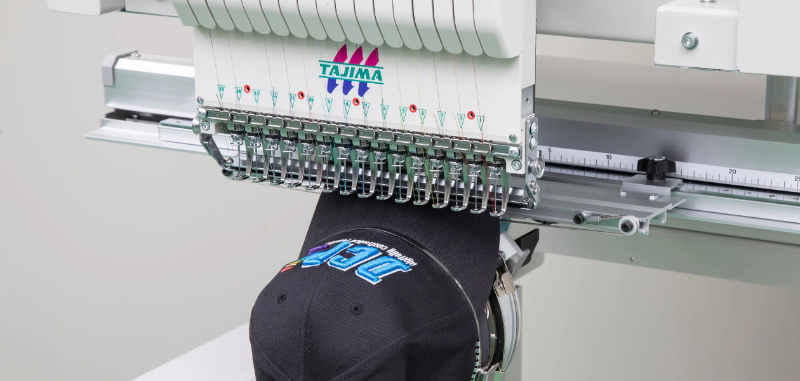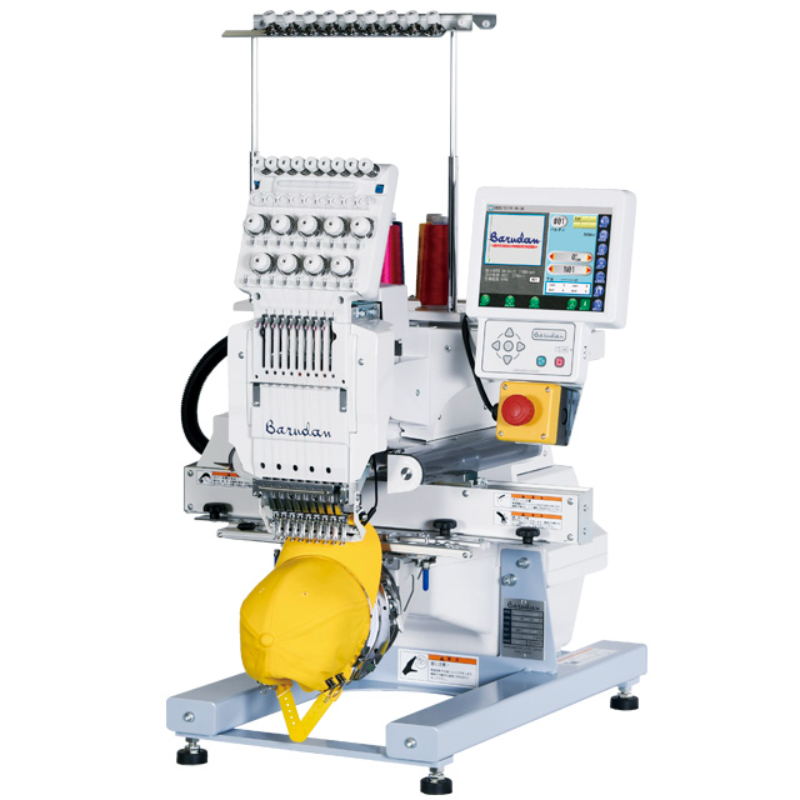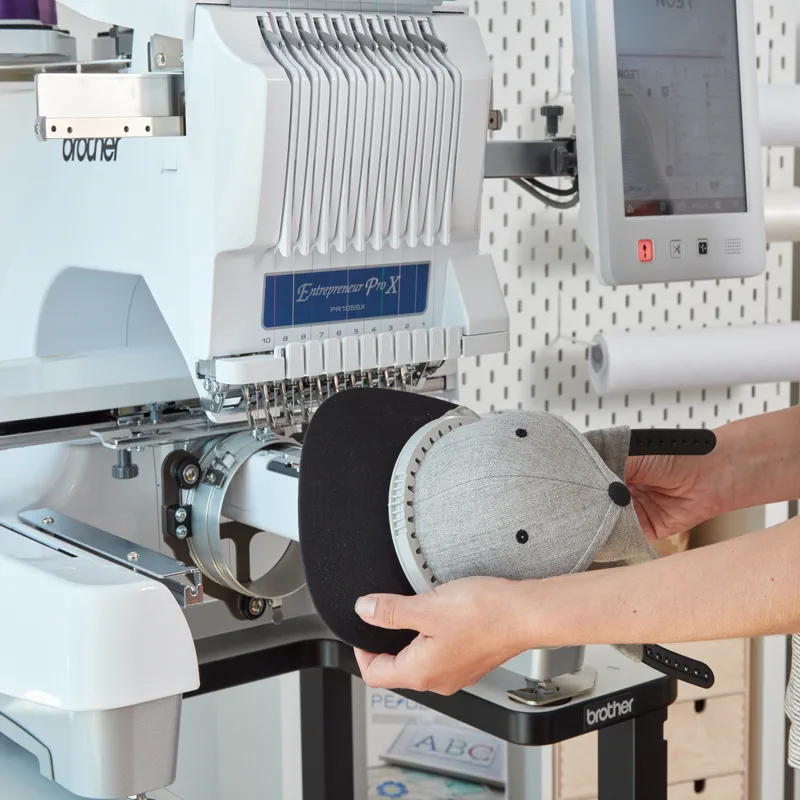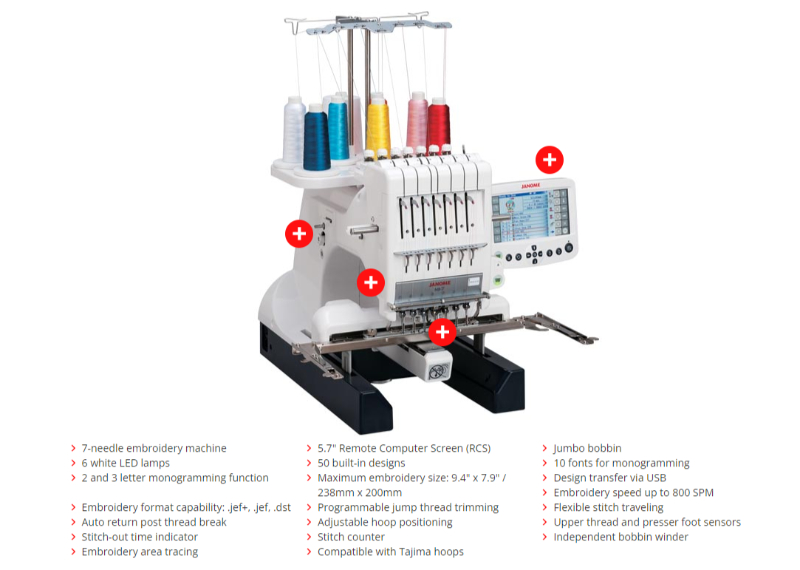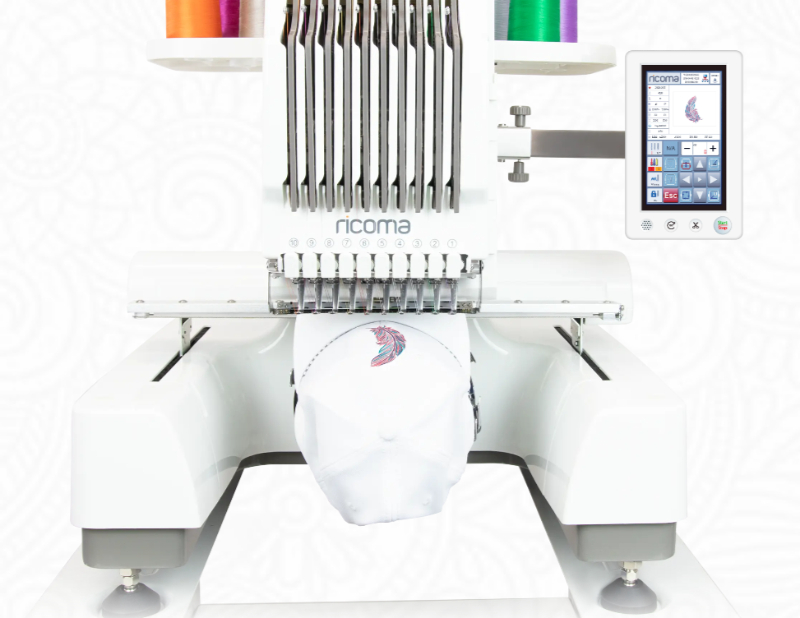Contents
Embroidery is an exquisite craft that requires extra attention to detail and acute precision. When it comes to hats, the challenge only grows. The curved structure and resistant materials can easily turn your design into a misaligned mess if you’re not using the right equipment. To properly embroider on hats, you need an embroidery machine with a built-in hat embroidery function.
Let’s dive into why these specialized hat embroidery machines are a game-changer and learn the best hat embroidery machine models in the market.
Do You Need a Special Embroidery Machine for Hats?
Yes. Unique traits of hats can create some challenges for regular embroidery machines.
Hats have a very different structure compared to other flat products: They have curved surfaces and structured fabrics. The curvature of a hat makes it hard to hoop and align.
As a result, the embroidery can turn out warped, distorted and misaligned, if not handled properly. Structured fabric also often resists the embroidery hoop, adding to the difficulty.
That’s why you might need a special machine for hat embroidery.
Hat Embroidery Machine vs. Regular Embroidery Machine
Tapping into embroidery can be both exciting and overwhelming, especially when it comes to choosing the right equipment.
You might wonder whether a regular embroidery machine will suffice for hat embroidery and if a specialized hat embroidery machine is a must. Let’s explore the key differences to help you decide which machine best suits your needs.
Regular Embroidery Machines
- Flatbed frame: These machines are designed with a flatbed, ideal for handling a variety of fabrics. However, they are just suitable for flat apparel items like shirts, bags, and towels.
- Regular hooping: These hoops clamp the fabric flat between two frames, ensuring that the fabric remains taut and evenly stretched during embroidery.
- Embroidery area: Regular embroidery machines offer a more extensive embroidery area, which is excellent for larger designs.
Hat Embroidery Machines
- Curved frame: Unlike their flatbed counterparts, these machines are equipped with special frames and hooping systems designed to handle the unique challenges of curved surfaces. They come equipped with cap frames that fit the curved form of hats. This unique frame holds the fabric securely, ensuring that hats stay in place during the embroidery process and your designs stay crisp and clear.
- Cap hooping: Besides the curved frame that accommodates the curve of a hat, hat embroidery also uses a special hooping system to provide better stabilization. Instead of napping the fabric with a hoop, the cap frame usually grips the hat’s brim and wraps around the front of the hat to secure the hat tightly in place and align the design precisely.
- Embroidery area: Hat machines are optimized for smaller, more precise areas, making them perfect for intricate designs on caps.
With a hat-specific machine, you gain enhanced control over where your designs go. No more guessing or hoping it turns out right.
What you should choose?
- Regular embroidery machines are versatile and ideal for hobbyists who work with a variety of fabrics. They are akin to a general-purpose tool, capable of handling a wide range of tasks.
- Hat Embroidery Machine: For hobbyists, a regular machine may offer enough flexibility and functionality. However, commercial users who specialize in hat embroidery will find the precision and efficiency of a hat-specific machine invaluable. It’s like choosing between a sedan and a sports car—both get you where you need to go, but one is built for speed and precision.
So, what are your embroidery aspirations? Whether you’re a hobbyist dabbling in various projects or a commercial user focusing on hat embroidery, selecting the right machine can make a significant difference in your craft.
>>> Read more: Learn how to start an embroidery business from scratch
Best Hat Embroidery Machines
Selecting the ideal hat embroidery machine can feel like a daunting task with so many options on the market. Each machine brings its own set of features and benefits, catering to different needs and preferences. To simplify your decision-making process, let’s explore three standout models that have made a mark in the industry. This guide will walk you through their key features, benefits, and what users have to say about them, helping you find the perfect fit for your embroidery needs.
Melco EMT16X
Starting with the Melco EMT16X, this machine is often hailed as a top choice for commercial embroiderers. Why? Because it’s built for speed and scalability, making it a powerful asset for high-volume production.
Highlighted Features:
- Networkable Multi-head Modularity: Imagine being able to expand your production capacity seamlessly. The EMT16X allows you to link multiple machines together, creating a scalable embroidery operation.
- High Speed: With a capacity of up to 1,500 stitches per minute, this machine doesn’t just meet deadlines—it beats them.
- 16 needles: With 16 needles, this machine can handle multiple colored designs efficiently. Besides, it also helps you to cut down the production time.
- Thread Tension Control trademarked technology: Consistency is key in embroidery, and the automatic Patented Acti-Feed™ thread tensioning feature ensures every stitch is perfect.
- Especially, 14.1” x 3.25” Wide Angle Cap Frame provides easy hat embroidery.
Pros and Cons:
- Pros: The speed and modular design make it ideal for growing businesses. Plus, the stitch quality is top-notch.
- Cons: However, its higher price and complexity may not suit beginners.
Tajima TMBP2-SC
Next up is the Tajima TMBP2-SC, a name synonymous with precision and high-quality in the embroidery world. If your work demands intricate designs on a variety of materials, this machine is worth considering.
Highlighted Features:
- 15 needles: Multiple needles allow a maximum of 15 thread colors.
- Adjustable Presser Foot: This feature lets you work with different fabric thicknesses, making it versatile for various projects.
- Wide Embroidery area: Need to work on larger designs? The TMBP2-SC provides ample space, perfect for detailed embroidery. With an embroidery field of 14.4×20 inches, this machine is good for embroidery on T-shirts, large bags, sweatshirts, etc.
- User-Friendly Interface: Despite its advanced capabilities, the 12.1-inch touch control panel is intuitive, making it easier to manage complex projects. In addition, features like auto thread trimming and design position adjustment make the process much more effortless.
- A wide cap frame of 75×360 mm (2.9×14.1 inch) allows large embroidery on hats with a maximum speed of 1000 rpm.
- Wide applications of a variety of products with various choices of frames: Tubular frame, pocket frame, sock frame, border frame, Air type clamp frame, etc.
Pros and Cons:
- Pros: Precision and versatility are its strong points, making it a go-to for professional embroiderers.
- Cons: The downside? It comes with a hefty price tag, which might be daunting for smaller businesses.
This machine is praised for its ability to handle detailed work with ease. However, the cost is a common concern, especially for those just starting out.
Barudan BEKT-S901CAⅡ
If reliability is what you’re after, a Barudan machine is a solid choice. Originating from Japan, this brand is famous for its robust built, durability, and precision. This Barudan BEKT-S901CAⅡ in particular is a perfect choice for a hat embroidery engine.
Highlighted Features:
- Durable Construction: Built to withstand the rigors of continuous use, this machine is designed for longevity.
- High Stitch Quality: Even on challenging materials, the BEKT-S901CAⅡ delivers crisp, clean embroidery.
- Automatic Thread Trimming: This feature not only saves time but also ensures that your embroidery looks professional.
Pros and Cons:
- Pros: Durability and high-quality stitching are its major selling points.
- Cons: Its size and weight could be a drawback if space is limited, and the initial investment is substantial.
Barudan is loved for its durability and the consistent quality of its stitches. It’s a machine that many recommend for those who prioritize quality over quantity. This machine is also more suitable for commercial purposes and mid-size to big businesses.
Brother PR1055X
Let’s talk about versatility with the Brother PR1055X. This multi-needle machine is packed with advanced features that cater to both hobbyists and professionals, making it a popular choice across the board.
Highlighted Features:
- 10 Needles: This allows for seamless multi-color designs, minimizing the need for frequent thread changes.
- Large Embroidery Area (8" x 14"): The generous workspace is ideal for larger designs, particularly on hats.
- Built-In Cap Frame: Designed specifically for embroidering caps, this frame ensures a snug fit, keeping the fabric stable and preventing slippage during the embroidery process.
- Wireless Connectivity: Transfer designs directly from your computer or tablet through a mobile app, streamlining the embroidery process.
- Automatic Needle Threader: Saves time by automatically threading the needle, making the setup process quicker and more efficient, especially when switching between different colors.
- Advanced Color Sorting: The machine groups the stitching sequence by color, reducing the number of thread changes needed, which speeds up the embroidery process and enhances productivity.
Pros and Cons:
- Pros: Its multi-needle setup and large embroidery area are big advantages, especially for complex projects.
- Cons: However, the higher price and advanced features might be intimidating for beginners.
Brother PR1055X combines professional features and a user-friendly interface. The wireless connectivity is often highlighted as a game-changer.
Janome MB-7e
The Janome MB-7e strikes a balance between professional capabilities and ease of use, making it a favorite for those who want a professional-grade machine without the complexity.
Highlighted Features:
- 7-Needle Machine: Allows for multiple colors to be threaded simultaneously, reducing the need for manual thread changes. This is particularly useful for detailed designs on caps where multiple thread colors are involved.
- Cap Frame Compatibility: Specifically designed to work with a hat hoop, ensuring the fabric stays taut and secure during embroidery, which is crucial for achieving precise designs on the curved surface of caps.
- Large Embroidery Area (9.4" x 7.9"): Provides enough space to embroider larger designs on caps, or to place designs in multiple areas without rehooping.
- Jump Thread Trimming: Automatically trims the threads between sections of the design, saving time and ensuring a clean finish, especially on caps where multiple design elements are stitched close together.
- Compact Design: Despite its professional features, it’s designed to fit comfortably in smaller spaces.
Pros and Cons:
- Pros: It’s compact, easy to use, and offers multi-needle functionality.
- Cons: However, its embroidery area is smaller than some competitors, which may limit its use for larger projects.
The MB-7e’s compact size and ease of use make it a favorite embroidery choice for many, especially for small businesses or home studios looking to upgrade.
Ricoma EM-1010
Ricoma EM-1010 is a budget-friendly option that still packs a punch. Ideal for small businesses or home users, it offers professional features at an accessible price.
Highlighted Features:
- 10 Needles: Like the others, this machine handles multi-color designs efficiently.
- Touchscreen Interface: The easy-to-navigate interface simplifies operation, even for beginners.
- Affordable Pricing: Despite its professional features, it’s priced to be accessible for those just starting out.
Pros and Cons:
- Pros: Affordability and ease of use are its key strengths, making it a great entry-level machine.
- Cons: The stitching speed is slower, and the embroidery area is smaller, which may be limiting for some projects.
Users often praise the EM-1010 for its value and ease of use, especially as a starter machine. It’s a solid choice for those looking to dip their toes into commercial embroidery.
How Much Does a Hat Embroidery Machine Cost?
The price range for hat embroidery machines varies significantly depending on factors like functionality, brand reputation, and whether the machine is designed for home use or commercial production. On average:
- Entry-Level Machines: $1,000 to $5,000
- Mid-Range Machines: $5,000 to $10,000
- High-End/Commercial Machines: $10,000 to $20,000 and beyond
Here is the breakdown of all the hat embroidery machines on this list for your reference:
| Machines | Price Range | Price Range | Key Features | Ideal For |
| Ricoma EM-1010 | $5,000 – $7,000 | Entry-Level/Mid-Range | 10 needles, user-friendly, versatile for small business | Beginners, small businesses |
| Janome MB-7e | $6,000 – $8,000 | Mid-Range | 7 needles, professional-level features, compact design | Home-based businesses, hobbyists |
| Brother PR1055X | $12,000 – $15,000 | High-End | 10 needles, wireless capability, auto thread trimming | Small to mid-sized businesses |
| Barudan BEKT-S901CAⅡ | $12,000 – $18,000 | High-End/Commercial | High-speed, durable build, top-tier stitch quality | Commercial operators |
| Tajima TMBP2-SC | $14,000 – $18,000 | High-End/Commercial | Superior stitch quality, precision control, durability | Large-scale production |
| Melco EMT16X | $15,000 – $20,000+ | High-End/Commercial | Modular design, scalable, high-speed production | High-volume commercial use |
In case you are not sure if investing in an expensive hat embroidery machine is worth it, you can try print on demand embroidery. At Merchize, we offer print on demand embroidery hat at a very competitive price. We require no minimum quality, allow custom embroidery, and handle the embroidery process as well as the packaging and shipping for you. With this option, you can avoid all the hassle and keep the business compact and efficient.
Besides, Merchize also brings in many other print on demand embroidery products to diversify and expand your embroidery catalog:
- Embroidered Tote Bag
- Embroidered Hockey Jersey
- Embroidered Classic Unisex Sweatshirt
- Embroidered Shopping Tote Bag
- Embroidered Unisex T-shirt
- Embroidered Unisex Baseball Jersey
- Embroidered Lightweight Classic Unisex Hoodie
What to Consider When Choosing a Hat Embroidery Machine
Diving into the world of hat embroidery can be both exciting and challenging. The choice of machine can significantly impact the quality of your work and the ease with which you create designs. Whether you’re a beginner exploring new hobbies or a seasoned professional aiming to expand your business, selecting the right hat embroidery machine is crucial. Let’s delve into the key factors to consider, ensuring you make a choice that meets your needs and aspirations.
Single-Needle vs. Multi-Needle Machines
The journey begins with understanding the type of hat embroidery machine that will best suit your projects. The decision between single-needle and multi-needle machines is a pivotal one.
- Single-needle machines offer versatility for various tasks but require manual thread changes, which can slow you down.
- Multi-needle machines streamline the process by accommodating multiple thread colors at once.
So if you are going to work on a large hat volume then the multi-needle machine is a must. It will save you more time and help you to process orders faster.
15 needles is considered the standard for a commercial hat embroidery machine. It will help to get the embroidery done faster and more efficiently.
Cap Frame or Hooping System
One of the most crucial components in hat embroidery is the cap frame or hooping system, which keeps your project stable and precise. If you are shopping for an embroidery machine that can handle hat embroidery as well, look for a machine that comes with cap frames and a hooping system.
It should be noted that you can still opt for the regular embroidery without the specific cap frame to embroider designs on less structured caps, often softer, more flexible caps that can be easily flat out to fit into a regular embroidery hooping frame.
Besides, also take into consideration the number of cap drivers available for the embroidery machine.
Embroidery Area and Design Flexibility
Next, consider the embroidery area and the flexibility it offers for your designs.
The size of the embroidery area determines the complexity and scale of your designs. For hat embroidery, the embroidery areas are usually smaller than flat embroidery areas. However, it’s better to have a larger embroidery area on hats, preferably, ear to ear.
So when choosing your embroidery machine for hats, look at the embroidery size of the cap frame to see if it matches your needs.
Other factors
Along with the main function of embroidery, there are also other additional features that make the embroidery process easier. Here are a few factors that you should also consider when opting for the new embroidery
- User-Friendly Features: Modern machines often come with features like touchscreen interfaces and easy-to-navigate design import options. These can make the learning curve much gentler, allowing you to focus more on creativity than on mastering complex controls.
- Speed and Efficiency: For those who are aiming for high productivity, speed and efficiency are paramount. A machine’s stitching speed, measured in stitches per minute (SPM), directly influences how quickly you can complete your projects. Higher speeds can significantly boost productivity, especially when working on bulk orders.
- Build Quality and Durability: Investing in a durable machine can save time, money, and frustration in the long run. A well-built machine is less likely to break down and more capable of handling heavy use. It’s much like choosing a reliable vehicle for long journeys—you want something dependable.
- Brand Reputation and Support: Opting for well-established brands often means better customer support and more reliable warranties. This can be crucial if you encounter issues or need guidance on how to maximize your machine’s capabilities.
- Software and Compatibility: The software compatibility of your machine can expand or limit your creative potential. Ensure the machine you choose is compatible with the embroidery software you plan to use. Look for features that allow for design editing and support various file formats, giving you greater flexibility in your projects.
- Cost and Budget: While it might be tempting to go for the most affordable option, consider what features you might be sacrificing. Sometimes, investing a bit more upfront can lead to better results and fewer limitations.
- Extra Features (e.g., Automatic Thread Trimming, Lighting) and Their Benefits: Features like automatic thread trimming, built-in lighting, and advanced needle positioning can significantly enhance your workflow, making the embroidery process more efficient and enjoyable.
As you reflect on these factors, consider your specific needs and goals. Are you looking for a machine that offers maximum versatility, or do you need something more specialized for intricate hat designs? The right machine can open up a world of creative possibilities, allowing you to express your artistic vision with precision and flair.
Conclusion
Choosing the right embroidery machine for hats can make all the difference in the quality and efficiency of your work. Whether you’re a hobbyist or a commercial embroiderer, investing in a specialized hat embroidery machine can save you time, reduce frustration, and ensure your designs come out perfect every time. Now that you know what to look for, it’s time to take the next step and find the machine that suits your needs. Don’t let your creativity be limited—equip yourself with the right tools and start turning your ideas into reality!
